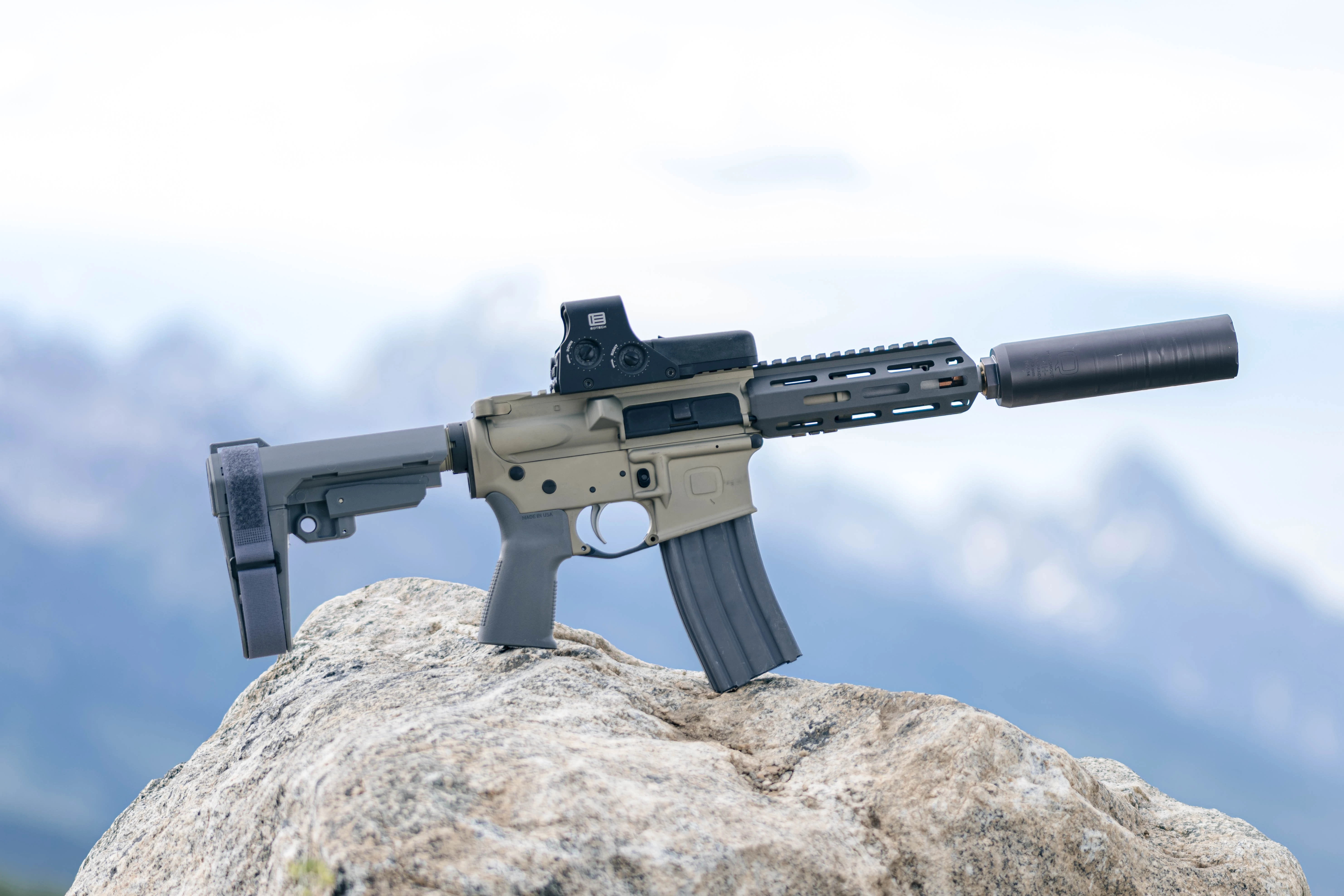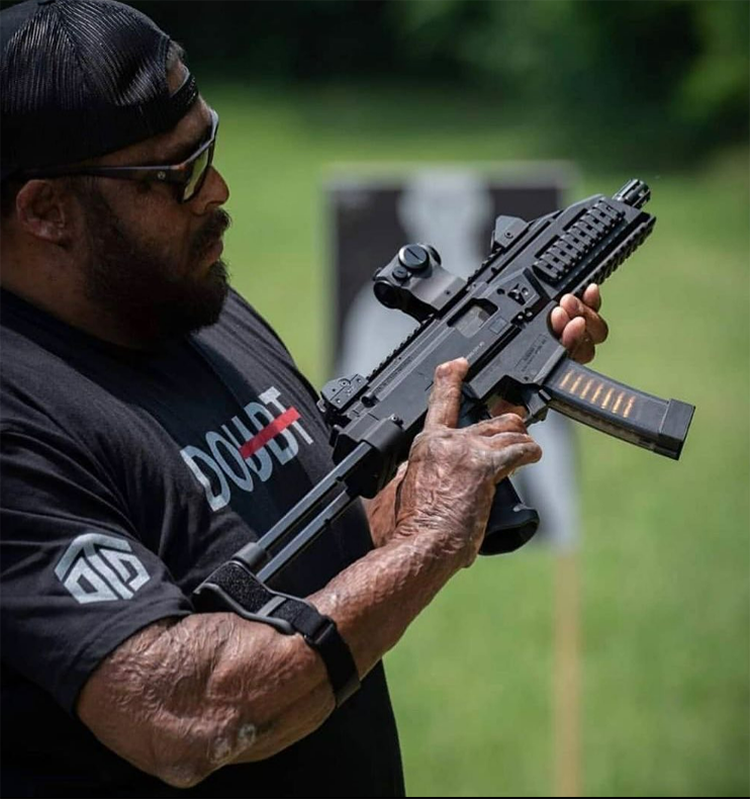2025 UPDATE: As of 2025, pistol brace legality remains largely intact following a series of key court decisions. In recent cases—including the notable Thompson v. ATF ruling and its reaffirmation in Johnson v. ATF—courts have upheld that pistol braces are legal when used on firearms meeting the legal definition of a pistol, provided they aren’t modified to function as short-barreled rifles. As always, gun owners should keep an eye on evolving regulations and legal interpretations to ensure full compliance.
Table of Contents
What is the Latest ATF Ruling on Pistol Braces?
The Bureau of Alcohol, Tobacco, Firearms, and Explosives (ATF) rule 2021R-08F called “Factoring Criteria for Firearms with Attached ‘Stabilizing Braces,’” is the latest ATF brace rule. This rule aimed to clarify if a firearm was made, designed, and intended to be fired from your shoulder, effectively classifying millions of braced pistols as short-barreled rifles which are subject to the regulations of the National Firearms Act (NFA). This 293-page rule uses vague language about what constitutes an SBR, including eye relief of the optic, the weight of the platform, and the general public's likely use of the weapon. The new ATF brace ruling has many citizens asking, will pistol braces be grandfathered in? No, the ATF will not be grandfathering in any braced weapon configurations that they deem to circumvent the NFA.


Are Pistol Braces Illegal Now?
The ATF clarified that pistol braces themselves are not subject to any sort of ban or regulation, as the agency does not regulate accessories. The ATF pistol brace rule does specify that many braced weapons, IE: firearms with an attached stabilizing or pistol brace, may be subject to the NFA as they could be SBRs. 2021R-08F does not specify what exactly makes a braced weapon an SBR or not, giving the ATF discretion to apply the rule as they see fit to individual examples. On the ATF’s website is a list of examples and configurations deemed to be SBRs but there is no list of ATF-approved pistol braces. If you are curious if your specific configuration qualifies as an SBR, you can submit your firearm to ATF’s Firearms and Ammunition Technology Division (FATD) for classification. SPOILER: Your firearm is almost certainly an SBR according to this rule.


Credit:@sb.tactical
Pistol Brace Amnesty Period
Included in rule 2021R-08F is a 120-day forbearance period, that started January 31, 2023, when the rule was added to the Federal Register. This ATF pistol brace amnesty period will serve as a window to give individuals time to comply with the new definition and rule by removing the brace, installing a barrel 16” or longer, registering the firearm as an SBR, or destroying the braced weapon. After the forbearance period concludes, firearms that are determined to be SBRs will be treated as unregistered NFA items, and penalties for possessing an unregistered SBR include fines of up to $250,000, up to 10 years in federal prison, and the loss of gun rights.


Credit: @sb.tactical
Do I Need a Tax Stamp for a Pistol Brace?
Yes, if your braced weapon meets the new criteria to be considered an SBR it will require a tax stamp to remain in that configuration. The new ruling does state that during the forbearance period, the ATF will waive the cost of an NFA tax stamp for those who choose to register their firearm as a short-barreled rifle. Registration can be done as an individual or a trust as long as the trust owned the firearm prior to the final rule being added to the register. This registration would be done via an ATF Form 1, which is the form required to manufacture an NFA item.


ATF eForm 1 Walkthrough
With Silencer Shop’s ATF eForm 1 service, filing for an SBR is easy.
- Login to your Silencer Shop account: if you don’t have an account you can quickly create one by selecting “Register as a “New User”. From the Dashboard, navigate to “eForm 1” on the top banner and click the “Start New Form 1” button. You’ll then be prompted to choose whether your submission will qualify for tax-exemption based on ATF pistol brace amnesty rule.
- You will need to enter a few pieces of information: We request a photo of the original engravings, including the manufacturer, model, caliber, city, and state. You will also need to enter this info in the appropriate fields. Input the barrel length and overall length that the firearm will have in its SBR configuration.
- Once your information is input:a member of our compliance team reviews your application packet and checks it for accuracy (Silencer Shop compliance has a 99.5% accuracy rate compared to the industry average of 60%).
- Upon a successful compliance review: your eForm 1 will be prepped for submission. You will get an email from DocuSign, please verify the information is correct and accept it. Then just look out for a “Ready to Certify” email, be aware this sometimes gets filtered to Junk/Spam folders.
- Certification can be done quickly and easily: from your own computer or mobile device right at home, just make sure to have your ATF eForms login and password ready!
Important Notes:
After you submit your Form 1 through Silencer Shop, the ATF will send you an email titled: "eForms Application Submission Notification for Permit/Control No: ######". This email has an attachment asking you to submit your fingerprints. Silencer Shop does this for you!
If you need any assistance, hovering over the “Need help” question mark (?) icons will provide useful information on how to fill out the indicated field.
Litigation and Lawsuits
Many law-abiding citizens are upset about the new pistol brace rule, calling it a registration scheme or a bait and switch by the ATF, which previously approved the use of pistol braces and braced weapons. Organizations such as the Firearms Regulatory Accountability Coalition (FRAC), The Second Amendment Foundation (SAF), and National Rifle Association (NRA) are leading the charge to oppose this rule with litigation and lawsuits against the ATF. These groups and others are calling the ruling an attack on the 2nd amendment and citing that only Congress can establish laws, not regulatory bodies such as the DOJ or ATF. We encourage you to support the organizations that are battling to make sure our gun rights shall not be infringed.
Frequently Asked Questions About Pistol Braces
Are pistol braces legal in Texas?
Yes, pistol braces are legal in Texas, but the ATF's rule may classify firearms with these braces as SBRs, requiring registration.
Do I need a tax stamp for an AR pistol brace?
If your AR pistol with a brace is classified as an SBR under the new ATF rule, you will need to obtain a tax stamp.
What happens if I don’t register my pistol brace-equipped firearm?
Failure to register a firearm that meets the SBR criteria can result in fines, imprisonment, and loss of gun rights.
Is the SBA3 pistol brace legal?
The SBA3 brace itself is not banned, but a firearm equipped with it may be considered an SBR under the ATF’s new rule.
How do I know if my pistol brace is legal?
The ATF’s website provides guidelines, but for specific configurations, you may need to submit your firearm to the ATF for classification.
Are AR-15 pistol braces illegal now?
The ATF’s new rule could classify AR-15 pistols with braces as SBRs, which would make them subject to NFA regulation.
What is the latest update on the pistol brace ban?
As of August 2024, federal courts have ruled the ATF's pistol brace restrictions as likely illegal, which may affect the enforcement of the ban.
Can I still buy pistol braces?
Yes, you can still purchase pistol braces, but be aware that attaching them to certain firearms may classify the firearm as an SBR under the new rule.
Are pistol braces legal in Virginia?
Pistol braces are legal in Virginia, but the ATF’s ruling may classify firearms with these braces as SBRs, which requires compliance with NFA regulations.
Is there a list of ATF-approved pistol braces?
The ATF does not provide a list of approved pistol braces. Instead, the classification depends on the firearm's configuration and how the brace is used.





